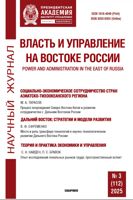Contents. №3 (76) 2016.
< briefly >
| № | Authors |
Article name |
File |
|---|---|---|---|
The Far East: new strategies and development models | |||
| 1. | N.M. Gorbunov E.N. Galicianin |
Barriers in social and economic development of the Far East | |
| The analysis of the social and economic situation which developed in the Far East of Russia is given in this article, measures for the removal of barriers on the way of its forward development come to light and proposed. In the macro-region it isn't possible to solve the main problem creating ge-opolitical threat so far – outflow of the population. The guarding factor is that among the territorial subjects of the federation at this process there are the regions holding a close border position with the adjacent foreign countries. Along with it, a considerable part as a part of decreasing popu-lation is constituted by the working-age persons having high professional training. Low, in comparison with the average Russian, social security of the population, turning of productions and reducing the workplaces are the basic reasons of such provision. Measures undertaken from the middle of the 90th didn't lead to essential shifts in a positive side of these processes. Acceptance of the new approaches and measures directed to the solution of this task is necessary. The territories of the advancing development (further – TAD), accomplishment of the orders of the Russian President directed to the removal of tariff restrictions in the energy industry and on transport, development and adoption of the special Federal law "About Development of the Far East" can become those, according to the authors, along with the further enhancement of a program and a target method. | |||
Theory and practice of administration | |||
| 2. | T.V. Ignatova | Political and economic factors of integration processes in the Russian elite | |
| The article argues that to assess consolidation of the society and its’ elite, to elaborate mechanisms of national security provision the meth-odological instruments of dialectics are necessary. It will allow determine the measure and limits of consolidation and reconsolidation, to find out its’ essential difference from integration and reintegration of the society. It is shown that consolidation of the society has it’s qualitative and quantitative measure and qualitative and quantitative assessment of consolidation al-lows to determine essence of category, it’s modern incarnation, trends of strengthening or weakening, to present mechanisms of national security provision due to modern stage of development. Consolidation is viewed as a specific case of integration under coinsicion of the society and the state preferences, society and personal interests, interests of different elites and the state as a whole. Efficiency of the social development principles imple-mentation depends mostly on integration of the society as a new quality of adoption of the differently aimed interests but not consolidation on the only one platform. | |||
| 3. | A.B. Bardal | Transport complex: experience of regional strategic planning | |
| In the article approaches to strategic planning of a transport com-plex at the level of the territorial subject of the Russian Federation are con-sidered. "The transport block" of region strategic development documents shall be constituted taking into account: the transport target development vectors, pledged at the federal level; specifics of economic development of the territory (its industry structure, spatial localization of economic activity and the existing settlement system); key parameters of social and economic development of this territory in the long term. Experience of strategic direc-tions of the transport development for two territorial subjects of the Rus-sian Federation is provided: The Jewish Autonomous Region and the Kha-barovsk Territory. For each of regions the short analysis of transport com-plex functioning is given and the key development directions for the transport complex on prospect till 2030 are formulated. The dedicated di-rections correspond to the general objectives of social and economic de-velopment of the territories in the long term; allow improve operating con-ditions of business entities and to increase comfort of life for the popula-tion. | |||
| 4. | I.S. Belanov | Knowledge management in the Russian IT-company. Case study of the CROC company | |
| The paper describes knowledge management tools used by the Russian IT-company “CROC”, which provides services within the sphere of system integration and business processes automation. The CROC company pays special attention to foster the corporate culture facilitating open and free knowledge sharing among employees and eliminating inefficient competition between employees, which manifests itself in concealing professional knowledge due to the fear to lose professional competitive advantage. The paper describes the main tasks of the CROC company within the scope of knowledge management including providing high professional level of key employees of the company, establishing infrastructural base for knowledge transfer between employees, deployment of IT environment facilitating inner communicational processes. On the basis of an interview with representatives of the company the description of knowledge management technologies employed in the company is made: non-financial motivation for knowledge sharing integrated with inner corporate IT-network; corporate university as integrated mechanism for employees education; customized CROC MBA program for education of key employees of the company; on-boarding and mentoring tools as a way for efficiency increase of new employees. |
|||
| 5. | A.V. Yaroslavtsev | Public-private partnership in the housing-and-municipal sphere as the mechanism of solution of the social tasks | |
| Within the Strategy of development of the housing and communal services in the Russian Federation for the period till 2020 the state made the decision to work a question of use of the other forms of public-private partnership (on the equal basis with concession) for the purpose of attraction of private investments into the housing-and-municipal sphere. Since January 1, 2016 the Federal law of 13.07.2015 No. 224-FL "About the public-private partnership, municipal and private partnership in the Russian Federation and modification of the separate legal acts of the Russian Federation" which purpose is a creation of legal conditions for investment attraction in the economy and improvement of the quality of goods, works, services in different spheres of the national economy, including in the housing-and-municipal sphere works. Use of the mechanisms of public-private partnership in the housing-and-municipal sphere will allow attract investments into the economy and to increase the goods quality, works, services, and also to improve the infrastructure condition. In the article the value of partnership of the state and business for the solution of tasks in the social sphere is revealed. | |||
Economy | |||
| 6. | O.G. Ivanchenko S.I. Ivanchenko A.Y. Titkova |
Instruments for supporting of industrial and financial sectors of the economy in terms of its instability | |
| Instability in the economy for the last decades has financial nature. It was accompanied by worsening of external and internal market conditions, demand reduction for the products of industrial enterprises, especially for the products of the processing industry enterprise. Economy instability leads to the GDP decline, capital outflow from industrial and financial sectors of economy, investment, lending activity decrease. In these circumstances the role of state support instruments and measures increases. Banking sector is a leading institute of investment and current activity of business financing. In circumstance of instability and crisis, accompanied by capital outflows and restrictions to attract foreign sources of financing the role of the banking sector increases. For the last several years role of the microfinance organizations in providing financial resources for small business activity rises. | |||
| 7. | O.M. Renzin T.I. Trop |
Credit behavior of the population: regional comparative analysis | |
| This paper investigates the regional differentiation of the consumer credit market, its dependence on the local characteristics of the income of the population. It estimated position of FEFD and its subregions among the federal districts and subjects of the Russian Federation. Quantitative relationship between the levels of regional development and characteristics of credit behavior of the localized population in the territory are analyzed. The dynamic characteristics analysis of the population’s loan debt in 2010 – 2015 was provided. It has been argued that the regional differentiation of volume and equity indices of two extreme decile groups of the regions - ten leaders and ten outsiders - is extremely high and has a tendency to expand. Furthermore, it is shown that the most favorable economic conditions of dynamic changes occur in the regions with the small volume indicators, and during a crisis - on the contrary, in the largest. The position of FEFD and its subregions among the federal districts and subjects of the Russian Federation was estimated. | |||
| 8. | Yu.G. Stratiychuk G.V. Tsvetova |
Assessment of a credit risk of physical persons' portfolio of the credit institutions | |
| This paper investigates the regional differentiation of the consumer credit market, its dependence on the local characteristics of the income of the population. It estimated position of FEFD and its subregions among the federal districts and subjects of the Russian Federation. Quantitative relationship between the levels of regional development and characteristics of credit behavior of the localized population in the territory are analyzed. The dynamic characteristics analysis of the population’s loan debt in 2010 – 2015 was provided. It has been argued that the regional differentiation of volume and equity indices of two extreme decile groups of the regions - ten leaders and ten outsiders - is extremely high and has a tendency to expand. Furthermore, it is shown that the most favorable economic conditions of dynamic changes occur in the regions with the small volume indicators, and during a crisis - on the contrary, in the largest. The position of FEFD and its subregions among the federal districts and subjects of the Russian Federation was estimated. | |||
| 9. | M.A. Gritsko | Trends in the labor market in terms of reducing human potential and demographic load growth (on the example of the Far East) | |
| The article examines the main trends in the labor markets in the regions of the Far-Eastern Federal District. During the period of 2000 – 2015 the analysis of key labor market indicators: the number of economically active population, employment and unemployment. Distinctive features of the reaction of the Far-Eastern labor markets to crisis shocks in the economy. It is shown that in the Far East is more pronounced than the average in Russia, emerged the paradox of Russian unemployment, the essence of which is the lack of an inverse relationship between the growth of GRP and falling unemployment. Labour market development in the long term to 2030 will face the objectively existing restrictions caused by the reduction of own labor resources in the region and the growth of demographic load. | |||
| 10. | M.G. Mazitova | Intra-regional trade in the North-Eastern Asia: trends and prospects | |
| International separation of the production process and, as a result, forming of the complex regional and global production networks influences international trade. Increase in the amount of world trade in the last decades is connected with increasing of trade in intermediate goods which are used in the international production of final products. The greatest contribution to the world trade by intermediate goods is made by intraregional flows of commodities of the countries of the European Union, Eastern Asia and the member countries of NAFTA. Feature of the Eastern Asia is that the amount of intermediate trade of economies of the region steadily increased during the considered period against the background of reduction of amounts in the Northern America and Europe. In this article the main tendencies of international trade in the subregion of SVA are considered. The countries of "Big Triad" (the People's Republic of China, the Republic of Korea, Japan) take the leading positions in the intraregional export and import of intermediate products though for the export of the People's Republic of China the role of the Eastern Asia decreased that is connected with the growing integration of the country at the world markets. The shares of countries in trade in the primary goods and final products are changed during the considered period that is connected with the change of roles of the countries in the regional production networks. | |||
| 11. | A.V. Mikhal’chuk | Prospects of development of internal tourism in the residential suburb of Khabarovsk | |
| Value of internal tourism for the development of economy in a case of present economic and social situation is shown in this article. Perspective vacation spots, and also the directions for further development of internal tourism in the residential suburb of the Khabarovsk territory are considered. Several variants of development of internal tourism by creation of a complex tourist's product or a tourist route are offered, and also the proposals of respondents on the further prospects of development of internal tourism in the territory of the Khabarovsk territory are formulated. Tables, formula, figures, according to the sociological poll are given in the article. | |||
| 12. | L.E. Pyn’ko | Objective evaluation of the quality of life of the Amur region population in 2010 – 2014 | |
| The article discusses the theoretical and methodological basics of evaluation and analysis of the quality of life of the population in the Russian Federation entity. Brief theoretical bases of the analysis of the quality of life of population of the Russian Federation entity, brief methodical bases of quantitative evaluation of the indicators of the quality of life of the population of the Russian Federation entity, integrated in a composite index, have been laid out. The objective private indicators calculations are given and on their basis an integral indicator of the quality of life of the population for the Khabarovsk territory, the Amur region and Russia as a whole in 2014 compared to 2010 is provided. A comparative analysis of the quality of life of the Amur region population for the same indicators of the quality of life in the Khabarovsk territory and the average Russian indicators is presented. | |||
Sociology, philosophy, culturology | |||
| 13. | N.M. Baikov Yu.V. Berezutskiy O.E. Machkarina Yu.A. Melnitskaya |
Interethnic relations in the urban districts: conceptual approach to the policy and their sociological dimension | |
| The article discusses conceptual approaches to the strengthening of inter-ethnic relations in the city of Khabarovsk, the results of their sociological factors in measuring system and the conditions of a modern Russian society with the projection in the urban community. Based on official statistics and opinion polls results show the conditionality of international relations as the new challenges and threats, and subjective attitudes to their fellow countrymen of different nationalities and religion. It was established that under normal and peaceful state of interethnic relations in the city district, revealed a significant potential conflict and tension. It actualizes the need for the development and adoption of the municipal program of strengthening and development of international relations and ethno-cultural development of the urban community. | |||
| 14. | S.S. Khalikova | The Khabarovsk residents’ conceptions of food as a component of healthy lifestyle | |
| The article is mainstreaming healthy lifestyle issues, risk factors for diseases and the influence of healthy lifestyle on the health status of the population. The Khabarovsk residents’ feeding practices, their conceptions of rational nutrition and diet have been analyzed. Feeding habits, compositions, quality, balance and calorie contents of food, consumed by the citizens of Khabarovsk have been evaluated. Also gender and age differences of feeding practices have taken place in the research. The article is written on the basis of sociological research, devoted to the issue of risk factors for diseases and Khabarovsk citizens’ commitment to maintaining a healthy lifestyle. The article provides data based on questionnaires and the results of focus-groups on the stated issue. | |||
| 15. | E.A. Smirnova I.V. Lisovskaya |
Adolescence, risk and difficult life situation: the construction of social problem | |
| For the last decade there has been a growing interest research of adolescence in difficult life situations. This study is in line with social constructivist approach to adolescents. In this article, adolescence is analyzed from the perspective of social constructivism. Adolescence is considered as a construct that is in the plane of various scientific, media and public discourses. The article presents an analytical view of constructing the image of "difficult teenager" in context of public space, media and scientific discourses. However the contemporary sociological discourses regarding adolescence discussed in the article The key findings of the article is the identification of the concept of "adolescents in difficult life situation", based on an analysis of current discussions in the Russian and foreign studies. The study contributes to social constructivism theory. | |||
| 16. | T.V.Barmina E.V.Tolkachyova |
Deinstitutionalization of a social orphanhood: social and psychological aspects | |
| In this article methodological approaches to a concept of the category of orphanhood deinstitutionalization are analyzed based on what theoretical idea of the essence of deinstitutionalization of an orphanhood and a social orphanhood is offered, that allowed interpret, describe and explain more precisely empirically a number of the observed phenomena in the sphere of guardianship of the orphan children and the children without parental support. Besides, the problems of deinstitutionalization of a social orphanhood are reflected in a new judgment, conclusions are drawn on the effectiveness of managerial impact and the prospects of its enhancement are designated. | |||
| 17. | O.R. Averina I.N. Tsupko |
"The Holy War" and phenomenon of sacred in the patriotic education of youth | |
| "The sacred" is understood as a property of objects of reality, events, which are unusual and differ greatly from ordinary things. "Sacred space" and "sacred time period" are considered in the article. The author shows that religious and secular shrines are combined together in a sacred space, manifesting the continuity of traditions. Such properties of sacred time as "something opposed to profane, inhomogeneity", "heterogeneity" are analyzes in the article. It is shown that sanctification is a process when various phenomena, events, objects of reality become sacred, holy through rituals, through strict order procedure. The article also deals with the objects, events and rituals connected with the memory of the Great patriotic war and touches the problems of patriotic education of the young. | |||
| 18. | N.M. Medvedeva A.E. Budo E.A. Bessonova |
Possibilities of mediation in creating restoring justice: Legal and social aspects | |
| The article deals with the legal analysis of restoring justice technologies and ways of carring out reconciliation procedures. Main targets, tasks and directions regarding creation of mediation service net, organization of its work, stuff training, introduction of mediation and restoring practice into work with children and teenagers are presented in the article. It also touches upon the involvement of all state and public institutions taking part in bringing up and forming an individual from family to the institutions of higher learning, including bodies and organizations participating in studying a law violation suit. The article considers measures providing the efficiency of public governing in the sphere of right violation and child protection. The article characterizes restoring mediation as the process in which a mediator provides conditions for developing (restoring) an individual's ability to understand each other and agree on acceptable ways to solve a problem, arising from conflict or criminal situations. The article considers principles of restoring mediation which differ from the other methods in deciding conflict (arbitration court, reconciliation, classic mediation). | |||
Law | |||
| 19. | V.N. Timoshenko K.S. Chernov |
Legal agreement on the status of the USA Armed forces in the Republic of Korea as the anti-Americanism source in the South-Korean society | |
| The article is devoted to the peculiarities of the Agreement on the USA Armed forces status in the South Korea. In particular, the author analyses the items of agreement, which cause strong criticism, discontent and anti-Americanism in the South-Korean society. Because of the problem of anti-Americanism the agreement was revised twice, but the result did not resolve the problem. Moreover, the new amendments needs are actively used by the internal political forces in the XXI century. | |||
| 20. | T.S. Korobeynikova D.O. Shish |
About a need of enhancement of the legislation about the first-aid treatment in the Russian Federation | |
| This article is devoted to an enhancement of the legislation on the first-aid treatment to the victim. Foreign experience of regulation of the similar relations is analyzed. The circle of people, obliged to give by the law first aid is determined. The conclusion is drawn on a need of special regulation in the Russian Federation of the relations connected with the first-aid treatment. Adoption of the bill governing the relations connected with the first-aid treatment is offered. The authors suggest to fill this bill with the regulations about conditions and principles of the first-aid treatment, about legal responsibility for unintentional harming and for the wrong first-aid treatment. | |||
| 21. | R.M.Kashapov | The problems of application of the note to the article 134 of the Criminal Code of the Russian Federation: theory and practice | |
| The article is devoted to the detailed analysis of the notes to the article 134 of the Criminal Code of the Russian Federation. The author carried out both the theoretical analysis of a criminal and legal definition, and the analysis of a court practice. Examples from the judicial and investigative practice with the author’s comments are given. According to the author, literal interpretation of the note 1 to the article 134 of the Criminal Code of the Russian Federation allows draw a categorical conclusion that concerning the persons who committed crimes according to p.1 of the article 134 of the Criminal Code of the Russian Federation it is impossible to stop criminal cases in connection with a release from criminal liability. The courts are obliged to exempt such persons from punishment and only in cases if the perpetrators complied the conditions stated by the legislator in the note 1 of the article 134 of the Criminal Code of the Russian Federation. | |||
TPost-Graduate Research | |||
| 22. | E.A. Osipova | From the sustainable development of timber industry to the sustainable development of timber company | |
| The concept of sustainable development is one of the fastest growing areas of research in modern economics. This proved the need for sustainable development of macro-economic facilities such as the world as a whole, the state or macro-region and industrial complexes. At the same time the real debate revolves around sustainable development of economic entities. Some researchers believe that sustainable development of the company is financially sustainable of company. When the sustainable development of the company is a balanced socio-ecological-economic development based on the principles of adaptation and adaptability, related to the failure of economic entities on the orientation on economic growth and the achievement of efficiency. In this article, the author attempted to justify the dependence between sustainable development of companies and sustainable development of the industrial complex. | |||
















